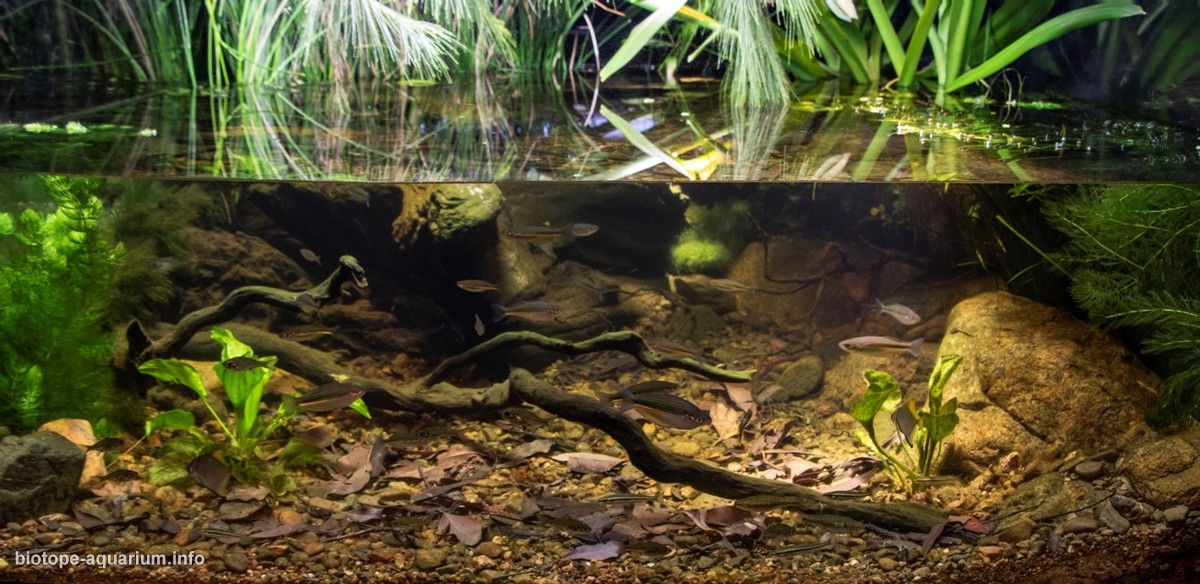Colleges crossing tidal freshwater reaches, Brisbane River, Chuwar, Queensland, Australia
24th place in Biotope Aquarium Design Contest 2019
Australia. Jason Sulda

Volume: 576 L
Dimensions: 120x120x60 cm
List of fishes: Melanotaenia duboulayi, Hypseleotris compressa, Craterocephalus stercusmuscarum, Monodactylus argenteus, Ambassis agassizii, Hypseleotris galii
List of plants: Crinum pedunculatum, Ludwigia repens, Ottelia alismoides, Persicaria decipiens, Ceratophyllum demersum, Vallisneria nana, Juncus usitatus
Description of decorations: Natural unwashed sand, Eucalyptus hollow, Callistemon root, Eucalyptus and Hoop Pine (Araucaria cunninghamii) leaves, Natural Brisbane River rock, River Sheoak (Casuarina cunninghamiana) branches overhanging the biotope.
Description of equipment: Eheim 300w heater set at 24deg C. Eheim Classic 2217 External Canister filter. 6 x 18w PAR38 LED Daylight 6500K Flood light bulbs.
Water parameters: Ph 8.0, Amonia (NH3/NH4+) 0.7ppm, Nitrite (NO2-) 0.03, Nitrate (NO3-) 0.2.
Additional info: This biotope has been getting 50% water changes every 2 days for filming purposes but normally only gets changed at 50% weekly basis, regular water changes have been done to clear the water of tannins from the driftwood and leaf litter, with the addition of a litre of salt water at water changes.
INFORMATION ABOUT BIOTOPE
Description of the area surrounding the biotope: The Brisbane river is a large river drainage located in South East Queensland Australia, it flows 344km from Brisbane River’s source which is located in the Great Dividing Range, east of Kingaroy. It then makes its way south, past Mount Stanley, and townships including Moore and Toogoolawah before being joined by the Stanley River, just south of Somerset Dam, the river runs from there into Lake Wivenhoe, created by the Wivenhoe Dam which is located 80kms west of Brisbane city. Beyond the dam, the river flows eastward, meeting the Bremer River near Ipswich, it flows through 2 of Queensland’s largest cities Ipswich and Brisbane below the dam wall there is another small weir at Mount Crosby where there is another small water treatment plant above the upstream tidal flow of seawater at Colleges Crossing where it still gets minimal salt if any, mainly in times of drought when the flow from upstream slows and the water from the incoming tide can flow further upstream than usual.
Description of the underwater landscape of the biotope: The Range of substrate rock can vary in this biotope, it could be Limestones, sandstone, quartzite, schists and dolomite created by the faulting and folding prosses from the Great Dividing Range where it originates from. It mainly consists of heavy smooth river rock where the flow is fast to small pockets of fine sand and leaf litter where it is slow flowing. Most of the river in the area has a lot of structure consisting of large fallen hollows and branches of the local Eucalyptus, Casuarina, Callistemon, Melaleuca trees that surround the river and are all hardwood so are long lasting in this landscape and feature good homes for its inhabitants.
Description of the parameters of the habitat: The water is mainly transparent at low tide and in good weather, it can get murky at the top of the tide, average temperature in summer is 23-24deg C. and in winter 19-22deg C. the water parameters at low tide, PH 8.0-8.8, (NH3/NH4+) 0, (NO2-) 0ppm, (NO3-) 0ppm, salt density 1.010 at high tide the water parameters didn’t change at the time of testing.
List of fishes and invertebrates occurring in the nature biotope: Fish species: Melanotaenia duboulayi, Hypseleotris compressa, Craterocephalus stercusmuscarum, Monodactylus argenteus, Ambassis agassizii, Hypseleotris galii, Ambassis marianus, Acanthopagrus australis, Pseudomugil signifier, Scatophagus argus, Notesthes robusta, Glossamia aprion, Carcharhinus leucas, Gerres subfasciatus, Arrhamphus sclerolepis, Trachystoma petard, Mugil cephalus, Megalops cyprinoides, Butis butis, Redigobius bikolanus, Mogurnda adspersa, Philypnodon grandiceps, Neoceratodus forsteri, Neoarius graeffei, Tandanus tandanus. Other species: Macrobrachium Bate, Paratya australiensis, Velesunio ambiguous, Cerithimorpha, Architaenioglossa.
List of plants found in the nature biotope: Crinum pedunculatum, Ludwigia repens, Ottelia alismoides, Persicaria decipiens, Ceratophyllum demersum, Vallisneria nana, Juncus usitatus, Azolla pinnata, Nymphoides indica, Colocasia esculenta, Hydrocotyle tripartite, Marsilea drummondii, Crassula helmsii, potamogeton crispus.
Threats to the ecology: This area of the river has gone through a lot of changes in recent years it has gone through 3 major floods the last being one of the biggest in 2011 where the water levels rose 17 metres at Colleges Crossing and devastated the region. It has now been turned into a recreational reserve for birds and aquatic species in the area of the biotope, but still faces dangers from development and pollution in other areas, it flows through two of Queensland’s major city’s Ipswich and Brisbane and is a major port at its mouth for the region and has been dammed at Wivenhoe 80kms west of Brisbane as a source of freshwater and to protect the two city’s from floods. It is also home to one of Australia’s prehistoric fish the Queensland lungfish (Neoceratodus forsteri) which could be threatened by the Mozambique mouth brooder, or tilapia, it has been declared a noxious and threatening alien species to the lungfish in Queensland.
Sources of information:
https://www.ala.org.au
https://www.angfa.org.au
https://www.qld.gov.au/environment/plants-animals/plants/herbarium/weeds
https://environment.des.qld.gov.au/water/monitoring/assessment/introduced_aquatic_pests.html
https://wetlandinfo.des.qld.gov.au/wetlands/facts-maps/wildlife/?AreaID=sub-basin-brisbane-river&Kingdom=plants&SpeciesFilter=Native
http://fishesofaustralia.net.au
